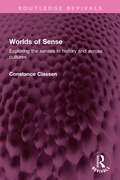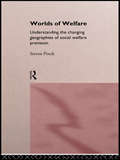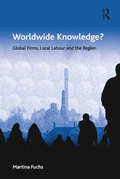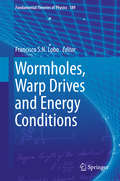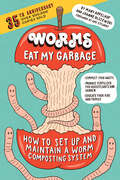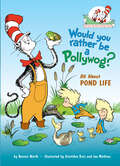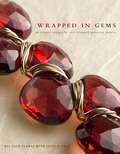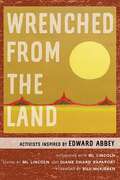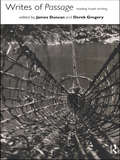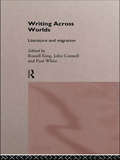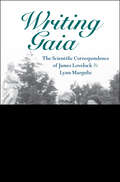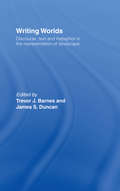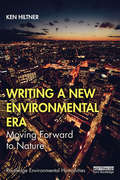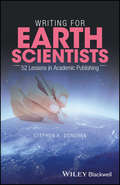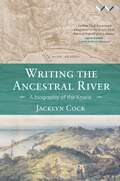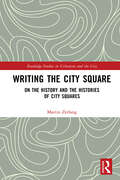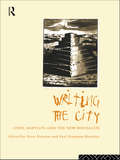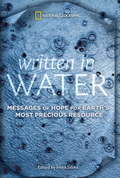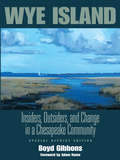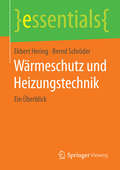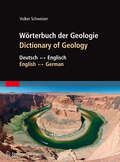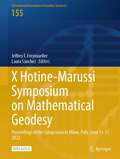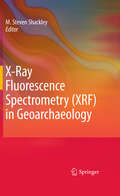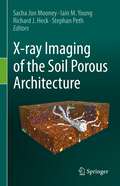- Table View
- List View
Worlds of Sense: Exploring the senses in history and across cultures (Routledge Revivals)
by Constance ClassenFirst published in 1993, Worlds of Sense is an exploration of the historical and cultural formation of the senses. As the author demonstrates, different cultures have strikingly different ways of ‘making sense’ of the world. In the modern urban West, we are accustomed to thinking in terms of visual models such as ‘world view,’ whereas the Ongee of the Andaman Islands, for example, live in a world ordered by smell and the Tzotzil of Mexico hold that temperature is the basic force of the cosmos. In a fascinating examination of the role of the senses in diverse societies and eras, Constance Classen shows the extent to which perception is shaped by and expressive of cultural values. This book will be of interest to students of cultural studies, sociology, anthropology, and philosophy.
Worlds of Welfare: Understanding the Changing Geographies for Social Welfare Provision
by Steven PinchThroughout the world welfare systems have been experiencing a period of unprecedented change. Understanding these changes is difficult, not only because of their diversity, but also because they vary so much from place to place. Worlds of Welfare provides a clear and concise guide to these changes. The first part of the book examines the range of different welfare states around the world, describing the various reforms - such as privatisation and commercialisation - which have been introduced in recent years. The second part of the book tests the many theoretical perspectives for understanding such social change. The book concludes with an exploration of the future of the welfare state in multicultural societies. Clearly written, with an extensive glossary of key terms, the book demonstrates how a geographical perspective is crucial to understanding the diversity of welfare reform. Worlds of Welfare will be of interest to all concerned for the future of welfare services.
Worldwide Knowledge?: Global Firms, Local Labour and the Region (Economic Geography Series)
by Martina FuchsPutting forward a comprehensive view of knowledge with a specific perspective on place and space, this book provides a new perspective on the globalisation of knowledge. Crossing disciplinary boundaries, the principal agenda of this volume is to open up a perspective ’beyond knowledge’ - i.e. beyond the interpretation of knowledge as scientific-technical knowledge. Author Martina Fuchs introduces further kinds of knowledge and interpretation which influence managements’ perception of globalisation and therefore the knowledge which is going global. She refers to knowledge in the sense of experiences, competencies in the production and labour process, as well as mutually shared mental constructs which are embedded in a context of understanding and interpretation. Exploring beyond the meaning of worldwide knowledge as general open access knowledge, this book also discusses barriers to knowledge, problems of transfer, and the influence of governance and control.
Wormholes, Warp Drives and Energy Conditions
by Francisco S. LoboTop researchers in the field of gravitation present the state-of-the-art topics outlined in this book, ranging from the stability of rotating wormholes solutions supported by ghost scalar fields, modified gravity applied to wormholes, the study of novel semi-classical and nonlinear energy conditions, to the applications of quantum effects and the superluminal version of the warp drive in modified spacetime. Based on Einstein's field equations, this cutting-edge research area explores the more far-fetched theoretical outcomes of General Relativity and relates them to quantum field theory. This includes quantum energy inequalities, flux energy conditions, and wormhole curvature, and sheds light on not just the theoretical physics but also on the possible applications to warp drives and time travel.This book extensively explores the physical properties and characteristics of these 'exotic spacetimes,' describing in detail the general relativistic geometries that generate closed timelike curves.
Worms Eat My Garbage, 35th Anniversary Edition: How to Set Up and Maintain a Worm Composting System: Compost Food Waste, Produce Fertilizer for Houseplants and Garden, and Educate Your Kids and Family
by Mary Appelhof Joanne OlszewskiFor more than three decades, this best-selling guide to the practice of vermicomposting has taught people how to use worms to recycle food waste into nutrient-rich fertilizer for houseplants or gardens. Small-scale, self-contained worm bins can be kept indoors, in a basement, or even under the kitchen sink in an apartment — making vermicomposting a great option for city dwellers and anyone who doesn&’t want or can&’t have an outdoor compost pile. The fully revised 35th anniversary edition features the original&’s same friendly tone, with up-to-date information on the entire process, from building or purchasing a bin (readily available at garden supply stores) to maintaining the worms and harvesting the finished compost.
Would You Rather Be a Pollywog? All About Pond Life: All About Pond Life (The Cat in the Hat's Learning Library)
by Bonnie WorthLaugh and learn with fun facts about pond animals, algae, metamorphosis, and more—all told in Dr. Seuss&’s beloved rhyming style and starring the Cat in the Hat! &“Near your house is a place of which I am fond. It&’s a body of water that we call a pond.&” The Cat in the Hat&’s Learning Library series combines beloved characters, engaging rhymes, and Seussian illustrations to introduce children to non-fiction topics from the real world! Join the Cat in the Hat and visit a pond to discover: the stages of frog developmentthe difference between complete and incomplete metamorphosishow amphibians spend part of their lives in the water and part on landand much more!Perfect for story time and for the youngest readers, Would You Rather Be a Pollywog? All About Pond Life also includes an index, glossary, and suggestions for further learning. Look for more books in the Cat in the Hat&’s Learning Library series!High? Low? Where Did It Go? All About Animal CamouflageIs a Camel a Mammal? All About MammalsThe 100 Hats of the Cat in the Hat: A Celebration of the 100th Day of SchoolA Great Day for Pup: All About Wild BabiesHappy Pi Day to You! All About Measuring CirclesI Can Name 50 Trees Today! All About TreesFine Feathered Friends: All About BirdsMy, Oh My--A Butterfly! All About ButterfliesOh Say Can You Seed? All About Flowering PlantsInside Your Outside! All About the Human BodyIce is Nice! All About the North and South Poles
Wrapped in Gems: 40 Elegant Designs for Wire-wrapped Gemstone Jewelry
by Mai Sato-Flores Jesse FloresFew people would argue against the beauty and appeal of gemstone jewelry, but some jewelry makers find themselves intimidated by the thought of working with these precious stones. With Wrapped in Gems, even inexperienced jewelry makers can learn to fashion their own beautiful gemstone creations using Mai Sato-Flores's preferred techniques of wire wrapping and working with chain. This method allows gems to hang so that light can shine through and show off their natural beauty. For the jewelry maker, inspiration can be found anywhere, but the exquisite beauty of nature is a favorite source. Take a moment to study the leaves of a tree or plant-the contours of a leaf suggest a shape for a pendant, the perfect combination of colors in the leaves and flowers hint at a color palette of precious gemstones to mimic it. The branches and twigs, the patterns of leaf growth, even the shape of the tree or plant itself can inspire ideas for earrings, bracelets, necklaces, and rings. Wrapped in Gems shows you how to interpret all that you see in nature to create jewelry with wire, chains, and beautiful gemstones. New York City-based jewelry designer Mai Sato-Flores is inspired by nature wherever she goes-be it the supermarket, Central Park, or right outside her door. In Wrapped in Gems, she shares the secrets of her work and the natural elements that inspire it. After demonstrating how gemstones and wire can be used to recreate the patterns and designs of nature, Mai provides instructions for 40 elegant pieces of gemstone jewelry from her own collections.
Wrenched from the Land: Activists Inspired by Edward Abbey
by ML LincolnWrenched from the Land features sixteen interviews with some of the most iconic eco-warriors to put themselves on the line for their beliefs. The activists featured in this book are inspired by the late Edward Abbey, one of America&’s uncompromising and irascible defenders of wilderness. The book includes interviews with Terry Tempest Williams, the late Charles Bowden, Sea Shepherd Society founder Paul Watson, Jack Loeffler, Doug Peacock, Ingrid Eisenstadter, John De Puy, Bob Lippman, Derrick Jensen, Shonto Begay, Ken Sanders, Ken Sleight, the late Katie Lee, Executive Director of the Center for Biological Diversity Kieran Suckling, Earth First! cofounder Dave Foreman, and climate activist Tim DeChristopher.Some were among Abbey&’s closest friends and were the inspiration for his irreverent comedic masterpiece, The Monkey Wrench Gang. Here are mesmerizing stories about how they adapted Abbey&’s monkeywrenching ideas into a radical blueprint for direct action. Their achievements—as ingenious and fierce as the individuals in this book—will encourage readers to discover their own pathways toward positive change.
Writes of Passage: Reading Travel Writing
by Derek Gregory James DuncanWrites of Passage explores the interplay between a system of "othering" which travelers bring to a place, and the "real" geographical difference they discover upon arrival. Exposing the tensions between the imaginary and real, Duncan and Gregory and a team of leading internationa contributors focus primarily upon travelers from the 18th and 19th Centuries to pin down the imaginary within the context of imperial power. The contributors focus on travel to three main regions: Africa, South Asia, and Europe - wit the European examples being drawn from Britain, France and Greece.
Writing Across Worlds: Literature and Migration
by Paul White Russell King John ConnellInternational migration has long been a dominant feature of world literature from both post-industrial and developing countries. The increasing demands of the global economic system and continued political instability in many of the world's region have highlighted this shifting map of the world's peoples.Yet, political concern for the larger scale economic and social impact of migration has effectively obscured the nature of the migratory nature of the migratory experience itself, the emotions and practicalities of departure, travel, arrival and the attempt to rebuild a home.Writing Across Worlds explores an extraordinary range of migration literaturesm from letters and diaries to journalistic articles, autobiographies and fiction, in order to analyse the reality of the migrant's experience. The sheer range of writings - Irish, Friulian, Italian, Jewish and South Asian British, Gastarbeiter literature from Germany, Pied noir, French-Algerian and French West Indian writing, Carribbean novels, Slovene emigrant texts, Japanese-Canadian writing, migration in American novels, narratives from Australia, South Africa, Samoa and others - illustrate the diversity of global migratory experience and emphasise the social context of literature.The geographic and literary range of Writing Across Worlds makes this collection an invaluable analysis of migration, giving voice to the hope, pain, nostalgia and triumph of lives lived in other places.
Writing Gaia: The Scientific Correspondence of James Lovelock and Lynn Margulis
by Bruce Clarke Sébastien DutreuilIn 1972, James Lovelock and Lynn Margulis began collaborating on the Gaia hypothesis. They suggested that over geological time, life on Earth has had a major role in both producing and regulating its own environment. Gaia is now an ecological and environmental worldview underpinning vital scientific and cultural debates over environmental issues. Their ideas have transformed the Earth and life sciences, as well as contemporary conceptions of nature. Their correspondence describes these crucial developments from the inside, showing how their partnership proved decisive for the development of the Gaia hypothesis. Clarke and Dutreuil provide historical background and explain the concepts and references introduced throughout the Lovelock-Margulis correspondence, while highlighting the major landmarks of their collaboration within the sequence of almost 300 letters written between 1970 and 2007. This book will be of interest to researchers in ecology, history of science, environmental history and climate change, and cultural science studies.
Writing Worlds: Discourse, Text and Metaphor in the Representation of Landscape
by Trevor J. Barnes James S. DuncanWriting Worlds represents the first systematic attempt to apply poststructuralist ideas to landscape representation. Landscape - city, countryside and wilderness - is explored through the discourse of economics, geopolitics and urban planning, travellers descriptions, propaganda maps, cartography and geometry, poetry and painting. The book aims to deconstruct geographical representation in order to explore the dynamics of power in the way we see the world.
Writing a New Environmental Era: Moving forward to nature (Routledge Environmental Humanities)
by Ken HiltnerWriting a New Environmental Era first considers and then rejects back-to-nature thinking and its proponents like Henry David Thoreau, arguing that human beings have never lived at peace with nature. Consequently, we need to stop thinking about going back to what never was and instead work at moving forward to forge a more harmonious relationship with nature in the future. Using the rise of the automobile and climate change denial literature to explore how our current environmental era was written into existence, Ken Hiltner argues that the humanities—and not, as might be expected, the sciences—need to lead us there. In one sense, climate change is caused by a rise in atmospheric CO2 and other so-called greenhouse gases. Science can address this cause. However, approached in another way altogether, climate change is caused by a range of troubling human activities that require the release of these gases, such as our obsessions with cars, lavish houses, air travel and endless consumer goods. The natural sciences may be able to tell us how these activities are changing our climate, but not why we are engaging in them. That’s a job for the humanities and social sciences. As this book argues, we need to see anthropogenic (i.e. human-caused) climate change for what it is and address it as such: a human problem brought about by human actions. A passionate and personal exploration of why the Environmental Humanities matter and why we should be looking forward, not back to nature, this book will be essential reading for all those interested in the future and sustainability of our planet.
Writing for Earth Scientists: 52 Lessons in Academic Publishing
by DonovanThe time has come. You are an Earth scientist. You’ve spent weeks, months, years working on this project – now is the time to pull it together for publication. You might be writing an undergraduate or graduate thesis, a research paper for a leading journal, a note for the newsletter of the local amateur scientific society, a book review or an abstract for a specialist geological conference. How do you make the transition from promising unpublished researcher to established academic author? Of course, the phrase ‘academic publishing’ covers a multitude of sins; monographs, research papers, book reviews, conference abstracts or whatever each requires a different approach. You have to decide what it is you are going to write and where to publish it. There are co-authors, supervisors of your degree, peer reviewers and editors to deal with on the way. But the only way to write like an academic is to write like an academic. . . where do you start? You could do much worse than start here. There are many books on how to write and be published aimed at research students and other aspiring academics. Many of these are readable, comprehensive and provide good advice. This book is composed of numerous short chapters on this subject, all directly relevant to one or more aspects of academic publishing and aimed particularly at the Earth scientists in the broadest sense. Geologists will be encouraged to use the book as much as a reference as a reader, ‘dipping in’ to the chapters that contain relevant tips, hints and comments to enable them to improve the paper that they are currently writing. The book is intended to be informative, readable and, above all, of practical application for all readers. In summary, the volume will be a readable compilation investigating many facets of academic publishing relevant to the Earth sciences. It will be of particular interest to postgraduate students, postdocs and new academics
Writing the Ancestral River: A biography of the Kowie
by Jacklyn CockWriting the Ancestral River is an illuminating and unusual biography of the Kowie River in the Eastern CapeThis tidal river runs through the centre of what used to be called the Zuurveld, a formative meeting ground of different peoples who have shaped our history: Khoikhoi herders, Xhosa pastoralists, Dutch trekboers and British settlers. Their direct descendants continue to live in the area and interact in ways that have been decisively shaped by their shared history. Besides being a social history, this is also a natural history of the river and its catchment area, where dinosaurs once roamed and cycads still grow. As the book shows, the natural world of the Kowie has felt the effects of human settlement, most strikingly through the establishment of a harbour at the mouth of the river in the 19th century and the development of a marina in the late 20th century. Both projects have had a decisive and deleterious impact on the Kowie. People are increasingly reconnecting with nature and justice through rivers. Acknowledging the past, and the inter-generational, racialised privileges, damages and denials it established and perpetuates, is necessary for any shared future. By focusing on this `little' river, the book raises larger questions about colonialism, capitalism, `development' and ecology, and asks us to consider the connections between social and environmental injustice.
Writing the City Square: On the History and the Histories of City Squares (Routledge Studies in Urbanism and the City)
by Martin ZerlangThe history of cities is also the history of city squares. The agora, the forum, the piazza, the plaza: All presuppose the idea of a center. It’s a material and mental phenomenon. Literature is an important part of this history, and the interplay between the square as physical space and the square as literature is the topic of this book. This is an encyclopedic book combining an overview of the history of city squares with a plethora of analytical examples of its reflection in literature: Literature uses the city square as a frame; city squares serve as frames for drama; novels and other kinds of literature comment on city squares; city squares are sources of inspiration for all sorts of literary activities. Socrates in the agora, Cicero in the Forum, Calderón in the Plaza Mayor, Corneille in the Place Royale, Richardson in Grosvenor Square, James in Washington Square, Woolf in Bloomsbury Square, Döblin and Gröschner in Alexanderplatz, Rodoreda in Diamond Square in Barcelona, DeLillo in Times Square, Al Aswany in Tahrir Square, the Maidanistas in the Maidan of Kyiv: These are just some of the examples presented and analyzed in this book. The book is of direct interest for researchers, students, and professionals such as architects and urban planners, but it is written in a way that makes it accessible for all readers with an interest in urban culture, architecture, history, literature, and cultural studies.
Writing the City: Eden, Babylon and the New Jerusalem
by Paul Simpson-Housley Peter Preston`The expression of human experience it embodies ... includes all personal history'. Saul Bellow's view of the city is far from that of classic geographical descriptions which look at growth or decline, demographic patterns, traffic flows and economic potential: these empirically conceived models of urban geography fail to accommodate the crucial human aspect of city life. Located at the interface of geography and literature, Writing the City visualizes the city through the hopes, aspirations, disappointments and pains of international novelists and creative writers. From Manchester, Montreal and Sydney to Osaka, Varanasi amd Odessa, cities become more than their built environment, more than a set of class or economic relationships: they are also an experience to be lived, suffered and undergone. Thus cities are seen in terms of the innocence of an Eden now lost, a threat of sinful Babylon and the promise of a New Jerusalem.
Written in Water
by Irena SalinaWritten in Water is an unforgettable collection of the true stories of people-men and women, politicians and scientists, laymen and experts-sharing in their own words what they have seen and what they have learned in their efforts to bring clean water to all.
Written in Water
by Irena SalinaWritten in Water: Messages of Hope for Earth's Most Precious Resource comprises a collection of essays authored by heroes and leaders in the field of water solutions and innovations--a broad range of people from varied disciplines who have contributed their hearts and minds to bringing awareness to and conserving Earth's freshwater supply. In their own words, authors tell of such tragedies as water slavery, drought, or contamination, as well as their own professional struggles and successes in pursuit of freshwater solutions. Contributors include: Alexandra Cousteau, social environmental advocate and granddaughter of legendary marine scientist Jacques Cousteau; Peter Gleick, environmental visionary and winner of a 2003 MacArthur "genius grant"; Bill McKibben, bestselling author and winner of a Guggenheim fellowship; Sylvia Earle, oceanographer and Time magazine's first "hero for the planet"; and Christine Todd Whitman, former head of the Environmental Protection Agency, along with more than a dozen other notable people.These visionaries' stories touch, surprise, and amaze as they help us see the essential role played by water in our world, our lives, and our future. These are all people who are thinking far beyond the realm of self; they are devoted to creating a better world for all of us.
Wye Island: Insiders, Outsiders, and Change in a Chesapeake Community - Special Reprint Edition
by Boyd GibbonsToday, most of the 2,800 tranquil acres that make up Wye Island are managed by the Maryland Park Service. However, from 1973 to 1974, the island was the site of a raging controversy. A major developer, James Rouse, wanted to build a compact waterfront village that would be surrounded by large estates, protected farms, and wetlands. A boyhood resident of nearby Easton, Maryland, Rouse hoped that the island could avoid the sprawl of unplanned subdivisions that were marring so many other places along the Eastern Shore. Combining history, journalism, character sketches, and sharp sociological insight, Boyd Gibbons presents the conflict over Wye Island in its multiple dimensions - as an example of the emerging community-based activism of the 1960s and 70s, and of a community that, while exercising its right to preserve its identity, denies opportunities for its members to improve their lives through change. In fact, Wye Island proves not to be the environmental David-Goliath struggle that might be expected. For one thing, residents opposed a development plan that can be regarded as an early model for 'smart growth.' And many were no more favorably disposed to a park or preserve than to a planned village. Their interest was in protecting the community from an invasion of immigrants from ethnically diverse Baltimore and Washington, and, where the wealthy were concerned, protecting some very private views of the water. In the end, rich landowners, poor 'natives,' and many recent newcomers opposed the Rouse project - distrusting change, and, above all, fearing 'outsiders.' The special reprint of Wye Island includes a new foreword by distinguished environmental historian Adam Rome, who explores the enduring themes of Wye Island in context of the current debates about land use, development, and sprawl.
Wärmeschutz und Heizungstechnik: Ein Überblick (essentials)
by Bernd Schröder Ekbert HeringBeim Wärmeschutz im Hochbau werden Maßnahmen getroffen, um in beheizten Gebäuden ein für Menschen behagliches Raumklima zu schaffen. Grundlegend ist hierzu die Wärmebewegung durch Bauteile, die es zu berechnen gilt. Mindestanforderungen an den Wärmeschutz im Winter sind nach DIN geregelt. Im Bereich der Heizungstechnik unterscheidet man Einzelheizgeräte für Wohnräume, größere Räume und Hallen. Für die Zentralheizung gibt es je nach Wärmeträger unterschiedliche Systeme. Heizkörper und Heizflächen treten in verschiedenen Ausführungen auf. Neben dem hierfür notwendigen Rohrnetz sind noch Armaturen und meist Umwälzpumpen nötig. Die Wärmeerzeugung erfolgt in Heizkesseln, eventuell unterstützt durch Wärmepumpen und Sonnenkollektoren. Auch Fernheizungen haben sich stellenweise etabliert.
Wörterbuch der Geologie / Dictionary of Geology
by Volker SchweizerWissenschaftliche Publikationen werden heute fast nur noch in Englisch verfasst. Sowohl für das Verständnis englischsprachiger Fachliteratur als auch für das Verfassen eigener Publikationen braucht man dringend ein verlässliches Fachwörterbuch. Auch Wissenschaftlern, deren Muttersprache nicht Deutsch ist, wird es für das Verständnis deutschsprachiger Literatur eine große Hilfe sein. Volker Schweizer hat sich als erfahrener Übersetzer großer geologischer Lehrbücher eine hohe Kompetenz erworben und dieses Wörtebuch zusammengestellt.
X Hotine-Marussi Symposium on Mathematical Geodesy: Proceedings of the Symposium in Milan, Italy, June 13-17, 2022 (International Association of Geodesy Symposia #155)
by Jeffrey T. Freymueller Laura SánchezThis open access volume contains the proceedings of the X Hotine-Marussi Symposium on Mathematical Geodesy which was held from 13 to 17 June 2022 at the Politecnico di Milano, Milan, Italy. Since 2006 the series of the Hotine-Marussi Symposia has been under the responsibility of the Inter-Commission Committee on Theory (ICCT) within the International Association of Geodesy (IAG). The ICCT organized the last five Hotine-Marussi Symposia held in Wuhan (2006), Rome (2009, 2013 and 2018), and Milan (2022). The overall goal of the ICCT and Hotine-Marussi Symposia has always been to advance geodetic theory which is indeed documented by the 22 research articles published in these proceedings. The jubilee X Hotine-Marussi Symposium was organized in 10 topical sessions covering all parts of geodetic theory including reference frames, gravity field modelling, adjustment theory, height systems, time series analysis, or advanced numerical methods. In total, 60 participants attended the Symposium who delivered 62 oral and 18 poster presentations. During a special session, five invited speakers discussed two basic concepts of physical geodesy – geoid and quasigeoid.
X-Ray Fluorescence Spectrometry (XRF) in Geoarchaeology
by M. Steven ShackleySince the 1960s, x-ray fluorescence spectrometry (XRF), both wavelength and energy-dispersive have served as the workhorse for non-destructive and destructive analyses of archaeological materials. Recently eclipsed by other instrumentation such as LA-ICP-MS, XRF remains the mainstay of non-destructive chemical analyses in archaeology, particularly for volcanic rocks, and most particularly for obsidian. In a world where heritage and repatriation issues drive archaeological method and theory, XRF remains an important tool for understanding the human past, and will remain so for decades to come. Currently, there is no comprehensive book in XRF applications in archaeology at a time when the applications of portable XRF and desktop XRF instrumentation are exploding particularly in anthropology and archaeology departments worldwide. The contributors to this volume are the experts in the field, and most are at the forefront of the newest applications of XRF to archaeological problems. It covers all relevant aspects of the field for those using the newest XRF technologies to deal with very current issues in archaeology.
X-ray Imaging of the Soil Porous Architecture
by Sacha Jon Mooney Iain M. Young Richard J. Heck Stephan PethThe advent of X-ray Computed Tomography (CT) as a tool for the soil sciences almost 40 years ago has revolutionised the field. Soil is the fragile, thin layer of material that exists above earth’s geological substrates upon which so much of life on earth depends. However a major limitation to our understanding of how soils behave and function is due to its complex, opaque structure that hinders our ability to assess its porous architecture without disturbance. X-ray imagery has facilitated the ability to truly observe soil as it exists in three dimensions and across contrasting spatial and temporal scales in the field in an undisturbed fashion. This book gives a comprehensive overview of the “state of the art” in a variety of application areas where this type of imaging is used, including soil water physics and hydrology, agronomic management of soils, and soil-plant-microbe interactions. It provides the necessary details for entry level readers in the crucial areas of sample preparation, scanner optimisation and image processing and analysis. Drawing on experts across the globe, from both academia and industry, the book covers the necessary “dos and don’ts”, but also offers insights into the future of both technology and science. The wider application of the book is provided by dedicated chapters on how the data from such imagery can be incorporated into models and how the technology can be interfaced with other relevant technical applications. The book ends with a future outlook from the four editors, each of whom has over 20 years of experience in the application of X-ray CT to soil science.
